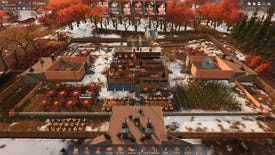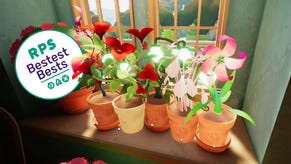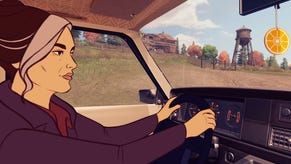Stranded: Alien Dawn review: a survival sim that nails the crashlanding
Good thing you can build a wedding arch because I’m in love
As our shuttle hits the ground, the world erupts into smoke, chaos, and confusion. Samantha, one among my ragged band of survivors, breaks down sobbing on the ground and I direct Maki, a veterinarian, to do something about it. She punches Samantha full-on in the face, knocking her unconscious (“Oh, I guess that’s what ‘knock out’ means,” I realize a moment too late). Well, at least I don’t have to worry about her running off into the woods or something. It’s a rough start, but they have no choice but to work together from here on out.
For fans of the survival simulation genre, crashlanding on an alien planet is a familiar premise, but it's one Stranded: Alien Dawn absolutely smashes. This game has been at the top of my to-be-played list for a while and now that it’s exiting early access for a full release, it’s safe to say that Stranded is the closest thing to my dream human vs nature survival game I’ve seen yet.
The game starts up pretty much how you would expect: you choose a difficulty level, one of three scenarios, and one of two biomes to play on before selecting your survivors from a set of several dozen premade characters. These choices aren’t just window dressing, though–while there aren’t many scenarios or biomes to choose from, each pairing offers a different set of goals and challenges that completely change the direction of the game. Each biome also has a unique mix of flora and fauna which your survivors must study closely in order to carve out a niche for themselves on a new planet.
In the crashlanding scenario mentioned above, my ill-prepared survivors had the good fortune to land in a lush temperate forest where they were tasked with reinventing basic technology like hunting bows and housing. While they have a long road ahead of them if they’re going to make it back to their homeworlds, wood is plentiful enough that they can subsist easily on campfire cooking and build with little thought for where those resources are coming from.
.jpg?width=690&quality=80&format=jpg&auto=webp)
My desert military outpost, on the other hand, had a big headstart on tech but had to jump into the heavy lifting of generating electricity and replacing our rickety lean-to with a stone hut almost immediately because there were only a handful of trees to cook food and keep warm with during the frequently frigid days.
Finally, to shamelessly call back to my own RPS content, I’m thrilled to say that Stranded: Alien Dawn will Harvestmoon. That is, by tweaking the settings to turn off alien attacks during the trading post scenario, I was able to enjoy the early days of a peaceful pastoral existence focused on developing a village farmland aesthetic instead of battling hordes of alien bugs.
None of this is new to the genre, of course. Stranded: AD is clearly a descendent of RimWorld (among other titles) but, as much as I’ve enjoyed life on the Rim, Stranded’s emphasis on alien wilderness survival through scientific discovery is incredibly refreshing after years of wading through a constant barrage of raider attacks, psychic magic, trading caravans, and the guilt of ignoring basically every distress call or resource mission that pops up because I just don’t have it in me to focus on that many things at once.
.jpg?width=690&quality=80&format=jpg&auto=webp)
.jpg?width=690&quality=80&format=jpg&auto=webp)
.jpg?width=690&quality=80&format=jpg&auto=webp)
The long-term goals of each scenario also provide welcome narrative scaffolding for each playthrough. I’m constantly checking in on my progress toward the military outpost’s ansible relay, a comms system that will allow for further exploration of the galaxy, for example, in order to ensure my settlement is developing in the right direction. While I’m aware that at least some of RimWorld’s scenarios had similar end-game goals, Stranded: AD’s streamlined focus means I actually have the bandwidth to pursue them.
The counterpoint to this, I suppose, is that Stranded isn’t quite so punishing a game, so you really need to pump up the difficulty (which determines your starting resources and how strong enemies are) and choose a challenging moon (which determines narrative pacing) if you want the alien ambushes to feel like anything more than a slightly chaotic welcome party. Or at least, I hope that’s enough to put an edge on things – I started both of my combat-enabled playthroughs on hard and have yet to feel any real thrill of danger, so the very hard and insane modes better bring out the big bugs if they want to be taken seriously.
"The long-term goals of each scenario also provide welcome narrative scaffolding for each playthrough"
Beyond that, I’d say Stranded compares quite favourably to its predecessors, keeping what works and improving on what hasn’t. The addition of more user-friendly, image-rich UI, smooths some of the rough edges off combat, research trees, and crafting, for example, and most of the features I “miss” from RimWorld are actually, upon further reflection, mods, not part of the core game itself–namely, custom character creation. This leaves me hopeful that some of these features, like custom scenarios, more efficient hauling, and deeper social relationships, could be added to the game by either the developers themselves or Stranded: AD’s burgeoning modding community down the line.
.jpg?width=690&quality=80&format=jpg&auto=webp)
Comparisons aside, Stranded: AD has plenty to offer players looking to immerse themselves in the role of deep space survivalist. Its modular base building, one of the primary features touted on the developer’s website, just works, allowing you to effortlessly create cozy cottages, multi-story buildings, and sprawling military complexes that fit seamlessly into the world. Most importantly, perhaps, the environments are not just beautiful window dressing–in order to make the most of nature’s abundance, you survivors need to set time aside not only to research technological advancements but to closely observe every species of plant and animal they encounter. You can also explore more distant locales through hot air balloon expeditions that can net you additional resources or survivors. Together, these science-forward features contribute to a real sense of discovery, making the world feel jam-packed with things to do even though, in reality, the slice of the planet available to you is actually rather small.
Stranded: AD may not contain an entire galaxy’s worth of possibilities, but it knows how to keep you curious about your little patch of land, and it's a pleasure to watch your survivors feast on the fruits of their labour–whether they be beefberries, graincob, or buttermelons.
This review is based on a review build of the game provided by the publisher Frontier Foundry.










